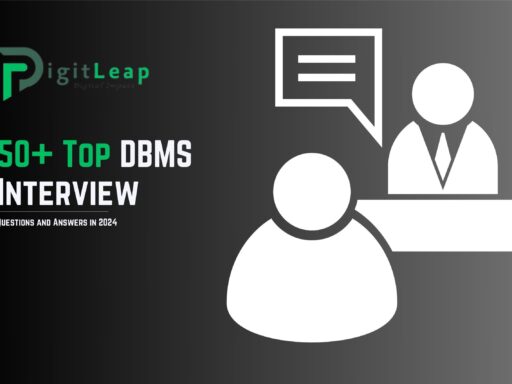Top 49+ Data Structures Interview Questions 2024 for 2024
1. What is a Data Structure?
Answer: A data structure is a way of organizing and storing data so that it can be accessed and modified efficiently. Common data structures include arrays, linked lists, stacks, queues, trees, and graphs.
2. What are the types of Data Structures?
Answer: Data structures are broadly categorized into:
- Primitive Data Structures: int, char, float, etc.
- Non-Primitive Data Structures: Arrays, Linked Lists, Stacks, Queues, Trees, Graphs, Hash Tables.
3. What is an Array?
Answer: An array is a collection of elements identified by index or key. All elements are of the same type, and arrays provide efficient random access to elements.
4. What is a Linked List?
Answer: A linked list is a linear data structure where elements are stored in nodes, with each node containing a reference (or link) to the next node in the sequence.
5. What is the difference between a singly linked list and a doubly linked list?
Answer:
- Singly Linked List: Each node contains data and a reference to the next node.
- Doubly Linked List: Each node contains data, a reference to the next node, and a reference to the previous node.
6. What is a Stack?
Answer: A stack is a linear data structure that follows the Last In First Out (LIFO) principle. Operations are performed at one end called the top.
7. What are the primary operations of a Stack?
Answer: The primary operations of a stack are:
- Push: Add an element to the top of the stack.
- Pop: Remove the element from the top of the stack.
- Peek: Get the top element without removing it.
- IsEmpty: Check if the stack is empty.
8. What is a Queue?
Answer: A queue is a linear data structure that follows the First In First Out (FIFO) principle. Elements are added to the rear and removed from the front.
9. What are the primary operations of a Queue?
Answer: The primary operations of a queue are:
- Enqueue: Add an element to the rear of the queue.
- Dequeue: Remove an element from the front of the queue.
- Peek: Get the front element without removing it.
- IsEmpty: Check if the queue is empty.
10. What is a Circular Queue?
Answer: A circular queue is a type of queue where the end is connected back to the front, making the queue circular. It helps in utilizing the available space efficiently.
11. What is a Priority Queue?
Answer: A priority queue is a type of queue where each element is associated with a priority. Elements with higher priorities are dequeued before elements with lower priorities.
12. What is a Hash Table?
Answer: A hash table is a data structure that maps keys to values using a hash function. It provides fast insertion, deletion, and lookup operations.
13. What is a Hash Function?
Answer: A hash function converts a given key into an index in the hash table where the value is stored. It ensures a uniform distribution of keys to minimize collisions.
14. What are Hash Collisions and how are they handled?
Answer: Hash collisions occur when two keys hash to the same index. They are handled using techniques such as:
- Chaining: Store collided elements in a linked list at the index.
- Open Addressing: Find another open slot in the table using probing.
15. What is a Binary Tree?
Answer: A binary tree is a tree data structure where each node has at most two children referred to as the left child and the right child.
16. What is the difference between a Binary Tree and a Binary Search Tree (BST)?
Answer:
- Binary Tree: A general tree where each node has up to two children.
- Binary Search Tree: A binary tree where the left child is less than the parent node, and the right child is greater.
17. What is a Binary Heap?
Answer: A binary heap is a complete binary tree where each node follows the heap property:
- Max-Heap: The value of each node is greater than or equal to its children.
- Min-Heap: The value of each node is less than or equal to its children.
18. What are the different types of Tree Traversal methods?
Answer: Tree traversal methods include:
- In-order Traversal: Left, Root, Right
- Pre-order Traversal: Root, Left, Right
- Post-order Traversal: Left, Right, Root
- Level-order Traversal: Nodes are visited level by level.
19. What is a Trie?
Answer: A Trie (prefix tree) is a tree-like data structure used to store strings where nodes represent characters. It is used for efficient retrieval and storage of string data.
20. What is a Graph?
Answer: A graph is a data structure consisting of a set of nodes (vertices) and a set of edges (connections) that link pairs of nodes.
21. What are the types of Graphs?
Answer: Graphs can be categorized as:
- Directed Graph (Digraph): Edges have a direction.
- Undirected Graph: Edges do not have a direction.
- Weighted Graph: Edges have weights.
- Unweighted Graph: Edges do not have weights.
22. What is a Depth-First Search (DFS)?
Answer: DFS is an algorithm for traversing or searching tree or graph data structures. It explores as far as possible along each branch before backtracking.
23. What is a Breadth-First Search (BFS)?
Answer: BFS is an algorithm for traversing or searching tree or graph data structures. It explores all nodes at the present depth level before moving on to nodes at the next depth level.
24. What is a Graph Cycle?
Answer: A cycle in a graph is a path that starts and ends at the same vertex without traversing any edge or vertex more than once.
25. What is the difference between a Tree and a Graph?
Answer:
- Tree: A type of graph with a hierarchical structure and no cycles. It has a single root node and every node has exactly one parent.
- Graph: Can have cycles and does not necessarily have a hierarchical structure.
26. What is a Union-Find Data Structure?
Answer: The Union-Find data structure, also known as Disjoint Set Union (DSU), is used to keep track of elements partitioned into disjoint sets. It supports union and find operations efficiently.
27. What is the purpose of a Min-Heap and Max-Heap?
Answer:
- Min-Heap: Used to quickly access the smallest element. It is useful in algorithms like Dijkstra’s shortest path.
- Max-Heap: Used to quickly access the largest element. It is used in algorithms like Heap Sort.
28. What is the concept of “Big O” notation?
Answer: Big O notation is used to describe the time complexity or space complexity of an algorithm in terms of the size of the input. It provides an upper bound on the growth rate of an algorithm.
29. What is the difference between time complexity and space complexity?
Answer:
- Time Complexity: Describes the amount of time an algorithm takes to complete as a function of the input size.
- Space Complexity: Describes the amount of memory an algorithm uses as a function of the input size.
30. What are the advantages of using a Linked List over an Array?
Answer:
- Dynamic Size: Linked lists can grow and shrink in size dynamically, while arrays have a fixed size.
- Efficient Insertions/Deletions: Insertions and deletions are more efficient in linked lists as they do not require shifting elements.
31. What is a Circular Linked List?
Answer: A circular linked list is a linked list where the last node points back to the first node, forming a circular structure.
32. What is a Doubly Linked List?
Answer: A doubly linked list is a type of linked list where each node contains a reference to both the next node and the previous node.
33. What is a Self-Balancing Binary Search Tree?
Answer: A self-balancing binary search tree is a type of BST that automatically keeps itself balanced to ensure efficient operations. Examples include AVL trees and Red-Black trees.
34. What is an AVL Tree?
Answer: An AVL Tree is a self-balancing binary search tree where the difference in heights between the left and right subtrees of any node is at most one.
35. What is a Red-Black Tree?
Answer: A Red-Black Tree is a self-balancing binary search tree where each node has an extra bit for color (red or black) to ensure balance during insertions and deletions.
36. What is a B-Tree?
Answer: A B-Tree is a self-balancing tree data structure that maintains sorted data and allows for efficient insertion, deletion, and search operations. It is commonly used in databases and file systems.
37. What is a Splay Tree?
Answer: A Splay Tree is a self-adjusting binary search tree where recently accessed elements are moved to the root to improve access times for frequently accessed elements.
38. What is a Skip List?
Answer: A Skip List is a data structure that allows for fast search, insertion, and deletion operations by maintaining multiple layers of linked lists.
39. What is the difference between a Depth-First Search and a Breadth-First Search?
Answer:
- DFS: Explores as far down a branch as possible before backtracking.
- BFS: Explores all nodes at the present depth level before moving on to the next level.
40. What are the advantages of using a Graph instead of a Tree?
Answer:
- Graphs: Can represent more complex relationships and structures, such as networks and social connections. They can have cycles and multiple paths between nodes.
- Trees: Are hierarchical and do not have cycles.
41. What is a Topological Sort?
Answer: Topological Sort is a linear ordering of vertices in a directed acyclic graph (DAG) such that for every directed edge uv from vertex u to vertex v, u comes before v in the ordering.
42. What is a Trie and its use cases?
Answer: A Trie is a tree-like data structure used to store a dynamic set of strings. It is useful for applications such as autocomplete, spell checking, and IP routing.
43. What are some common operations performed on Trees?
Answer: Common tree operations include:
- Insertion: Adding a node.
- Deletion: Removing a node.
- Traversal: Visiting nodes in a specific order.
- Searching: Finding a node with a specific value.
44. What is the difference between a Binary Search Tree (BST) and a Binary Tree?
Answer:
- Binary Tree: A general tree with nodes having up to two children.
- Binary Search Tree: A binary tree where the left child is less than the parent and the right child is greater.
45. What is a Segment Tree?
Answer: A Segment Tree is a data structure used for efficient range queries and updates on an array. It is particularly useful for problems involving interval or range queries.
46. What is a Fenwick Tree (Binary Indexed Tree)?
Answer: A Fenwick Tree, or Binary Indexed Tree, is a data structure that supports efficient updates and prefix sum queries on an array of values.
47. What is a Deque?
Answer: A Deque (Double-Ended Queue) is a linear data structure that allows elements to be added or removed from both ends, i.e., the front and the rear.
48. What is the purpose of a Union-Find Data Structure?
Answer: The Union-Find data structure is used to manage a partition of a set into disjoint subsets. It supports operations to find the representative of a subset and to union two subsets.
49. What is a Graph Adjacency Matrix?
Answer: An adjacency matrix is a square matrix used to represent a graph, where each element matrix[i][j] indicates whether there is an edge between vertex i and vertex j.
Download the Free PDF: Top 49 Data Structures Interview Questions 2024
Other Important Q&A List :
- OOPs Interview Questions And Answers
- SQL Interview Questions and Answers
- Content Writing Interview Questions and Answers
- Email Marketing Interview Questions and Answers
- Django Interview Questions and Answers
- C Programming Interview Questions and Answers
- ReactJS Interview Questions and Answers
- Angular Interview Questions and Answers
- Power BI Interview Questions and Answers
- Top DBMS Interview Questions and Answers
- Python Interview Questions and Answers
- MySQL Interview Questions and Answers
- Java Interview Questions and Answers
- Data Structures Interview Questions
- Flutter Interview Questions and Answers
- JavaScript Interview Questions and Answers
- PHP Interview Questions and Answers
- CSS Interview Questions and Answers
- HTML Interview Questions and Answers






